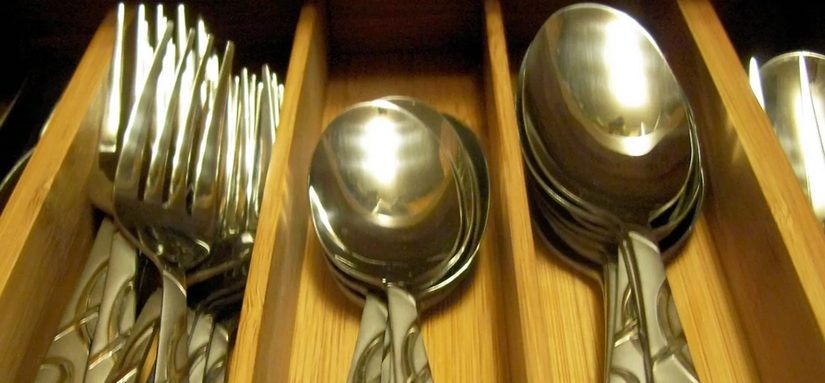Module 5: Sets (Chapter 5)
Section outline
-

Think of a drawer in your kitchen used to store flatware. This drawer likely holds forks, spoons, and knives, and possibly other items such as a meat thermometer and a can opener. The drawer in this case represents a tool used to group a collection of objects. The members of the group are the individual items in the drawer, such as a fork or a spoon.
The members of a set can be anything, such as people, numbers, or letters of the alphabet. In statistical studies, a set is a well-defined collection of objects used to identify an entire population of interest. For example, in a research study examining the effects of a new medication, there can be two sets of people: one set that is given the medication and a different set that is given a placebo (control group). In this chapter, we will discuss sets and Venn diagrams, which are graphical ways to show relationships between different groups.
Image Caption: A flatware drawer is like a set in that it contains distinct objects. (credit: modification of work “silverware” by Jo Naylor/Flickr, CC BY 2.0)
(Content & Image Source: Chapter 1 Introduction, Contemporary Mathematics, Donna Kirk, OpenStax, CC BY 4.0 License)
Upon completion of this module, you will be able to:5.1 Basic Set Concepts- Represent sets in a variety of ways.
- Represent well-defined sets and the empty set with proper set notation.
- Compute the cardinal value of a set.
- Differentiate between finite and infinite sets.
- Differentiate between equal and equivalent sets.
5.2 Subsets- Represent subsets and proper subsets symbolically.
- Compute the number of subsets of a set.
- Apply concepts of subsets and equivalent sets to finite and infinite sets.
5.3 Understanding Venn Diagrams- Utilize a universal set with two sets to interpret a Venn diagram.
- Utilize a universal set with two sets to create a Venn diagram.
- Determine the complement of a set.
5.4 Set Operations with Two Sets- Determine the intersection of two sets.
- Determine the union of two sets.
- Determine the cardinality of the union of two sets.
- Apply the concepts of AND and OR to set operations.
- Draw conclusions from Venn diagrams with two sets.
5.5 Set Operations with Three Sets- Interpret Venn diagrams with three sets.
- Create Venn diagrams with three sets.
- Apply set operations to three sets.
- Prove equality of sets using Venn diagrams.
To achieve these objectives:- Read the Module 5 Introduction (see above)
- Read Sections 5.1 - 5.5 of Chapter 5: Sets in Finite Mathematics (links to each Section provided below)
- Watch the Videos provided in the Video Lessons pages for each Section (links provided below)
- Complete the MyOpenMath Homework Assignments for each Section (links provided below) - These are graded!
- Complete the MyOpenMath Quiz for Chapter 5 (link provided below) - This is graded!
- Once you complete the Quiz, upload your work in the Quiz Work Upload Assignment using the submission link below.
- Post in the Chapter 5 Q&A Discussion Forum - link provided below.
Note the check boxes to the right that help you track your progress: some are automatic, and some are manual.Module Pressbooks Resources and Activities
You will find the following resources and activities in this module at the Pressbooks website. Click on the links below to access or complete each item.
Background Colour
Font Face
Font Kerning
Font Size
Image Visibility
Letter Spacing
Line Height
Link Highlight
Text Colour
